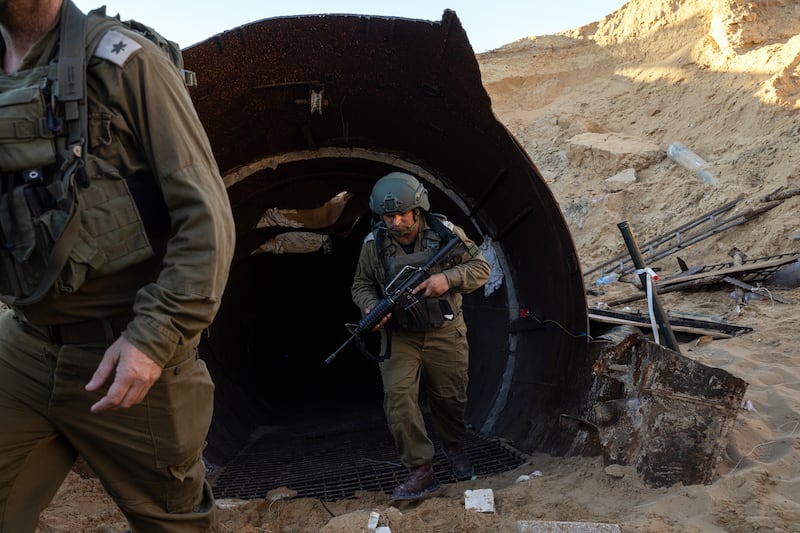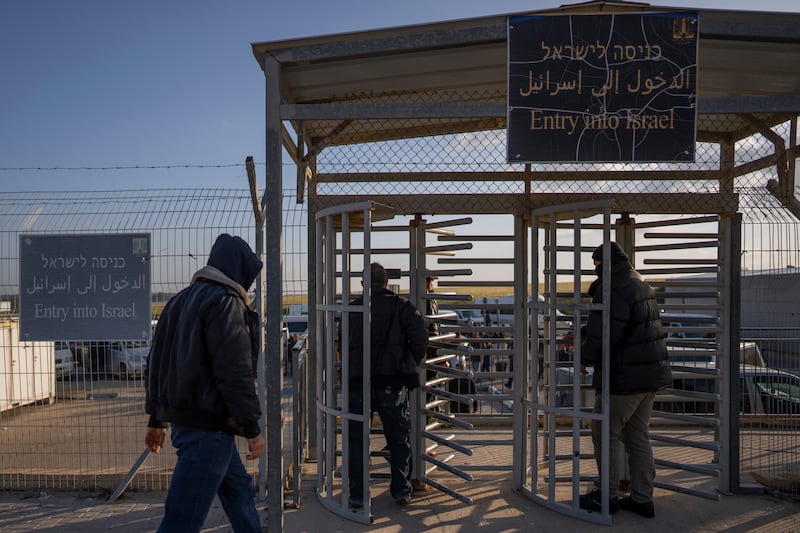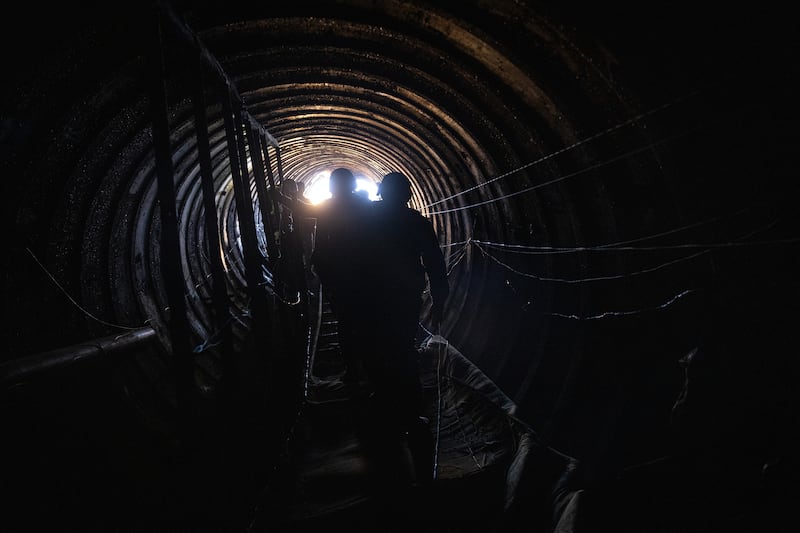At first the tunnel sloped gently downhill, and there was enough natural light to see the concrete-reinforced walls, dodge the tangle of electric cables and avoid the ventilation pipe hanging loosely from a wall.
But only 30m inside, the shadows thickened, the air grew hot and clammy, and the tunnel began a sharp descent into darkness. An Israeli army officer said it dropped dozens more metres before joining a vast underground network that Hamas had dug under Gaza.
“This is the biggest tunnel we have found, so far ... it was a flagship project,” said rear admiral Daniel Hagari, spokesperson for the Israel Defence Forces (IDF). “We estimate it is 50m deep and 4km long, and have found RPGs and AK-47s stored in depots. Many smaller tunnels lead off it.”
Destroying Hamas’s tunnel network is arguably the hardest part of the Israeli military’s mission in Gaza, and among its most important. Estimated to be as long as 500km, bigger than the London Underground and nicknamed the “Gaza metro”, it has enabled Hamas fighters to survive 10 weeks of relentless air strikes, ambush Israeli ground forces and prolong the fighting.
READ MORE
On Friday, the Israeli army took a group of journalists to see one tunnel that Hamas considered so significant that its construction was overseen by Mohammed Sinwar, brother and right-hand man of Hamas chief Yahya Sinwar, said Hagari.
A short video, assembled by the IDF from what the force said was Hamas footage, apparently showed Mohammed Sinwar being driven through the tunnel in a small car before the war began.

The group was led to a gaping steel-rimmed hole at the bottom of an excavated crater. Until the IDF discovered the site, it lay buried under several meters of sand in a patch of no-man’s land about 400 metres from the Erez terminal on the Gaza border.
This high-tech border crossing had an elaborate system of steel doors and scanners, through which travellers permitted by Israeli authorities would pass between Gaza and Israel. Today, Erez has become a military assembly point.
The ground was chewed up by armoured tracks, and troops milled around buildings ransacked by Hamas militants during their October 7th attack, when they left more than 1,200 Israelis dead and took about 240 people hostage.
It was hard to imagine that Israeli intelligence failed to pick up signs that Hamas had built a tunnel big enough to drive a car through so close to the border. If so, it would be just another in the string of security mistakes that Israeli officials have said will be investigated when the war ends.
But Mohammed – who is reported to have a $300,000 bounty on his head, second only to the $400,000 offered for his brother – is also a senior military commander. So Hamas followed tight operational security at the secret site as well.
Outside the tunnel, a young Israeli reserve soldier unfurled a poster, which Hagari said described security procedures for Hamas militants working on the project. Written in Arabic, one instruction said not to bring in mobile phones and to use landlines only.
Another said workers should not make it obvious to people when going in and out. Other instructions covered standard safety procedures, such as switching off machinery when finished.
It was an eerie experience to walk into the tunnel. Immediately inside the entrance, before the tunnel sloped steeply downwards, was a deep vertical shaft beneath the floor covered with steel rebars. The air was acrid and dust stung the nostrils.
The biggest feeling was how quickly the outside world dropped away. That, and the unnerving sense that a maze, likely riddled with explosive booby traps, extended as far as the above ground horizon.

The IDF held the tightly choreographed visit to see Hamas’s logistical capabilities as it came under further western pressure over the human cost of Israel’s Gaza offensive.
In part, the purpose of the trip was to demonstrate the Israeli army’s determination to defeat Hamas and its tunnel system at any price.
“Without demolishing the tunnel project of Hamas, we cannot demolish Hamas,” said Hagari. “They can try to hide but we will hunt them, even if it means we have to go down.”
In part the visit was to demonstrate the IDF’s military dilemma. As it seeks to eradicate Hamas and its military capabilities in Gaza while minimising losses among its own soldiers, the IDF has destroyed vast swaths of the strip, which is home to 2.3 million people.
The relentless bombing campaign has led to massive Palestinian casualties – about 19,000 dead, mostly women and children, and more than 50,000 wounded, according to Gaza’s health ministry. Even US president Joe Biden, who has staunchly backed Israel since Hamas’s October 7th attack, last week criticised what he called the “indiscriminate” bombing of the enclave.
The alternative is to use Israeli ground troops to clear urban areas. But that means incurring heavy Israeli casualties. Last week, nine Israeli soldiers were killed in fierce house-to-house combat after hidden Hamas fighters emerged from tunnels. In another incident, Gal Meir Eisenkot, son of war cabinet minister and former armed forces chief Gadi Eisenkot, was killed after a booby trap exploded by a shaft entrance.

After two hours on site, the journalists were led back to Erez. Incessant “crump” sounds came from the air strikes Israeli forces were launching a few kilometres to the south. The explosions sounded like thunder in an approaching storm, except that the sky was cloudless.
One Israeli reservist said she was determined to help vanquish the problem of the tunnels, but was also tormented by the thought of how many Gazans would continue to perish.
But that is a minority Israeli opinion. Last week, when US national security adviser Jake Sullivan urged an end to the IDF’s sustained bombardment, defence minister Yoav Gallant responded that Israel would continue to pursue major combat operations against Hamas for several more months.
“Hamas is a terrorist organisation that ... built infrastructure under the ground ... and it is not easy to destroy,” he said.
– Copyright The Financial Times Limited 2023
- Sign up for push alerts and have the best news, analysis and comment delivered directly to your phone
- Find The Irish Times on WhatsApp and stay up to date
- Our In The News podcast is now published daily – Find the latest episode here












